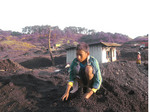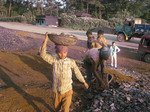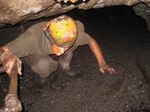2010.6.5
Immediate Release
Press Statement on HRN Fact-finding team in India, June 2010
1. Human Rights Now, a Tokyo-based international
human rights NGO, conducted a fact finding mission from May 31 to June 2nd to investigate
the extremely hazardous situation of child labor around the coal mines of Jaintia
Hills in the state of Meghalaya with Impulse NGO Network, based in Shillong,
Meghalaya.
The HRN fact finding mission conducted
three days of extensive investigation in 3 coal mines. We conducted interviews of
45 people including workers, children, families, supervisors, managers and
owners. Among the 45, we interviewed three children each of ages 12, 13, 14, 15
and 16 involved in coal mining. We also interviewed five 17 year old children
and six 18 year olds who are
involved in coal mining. We greatly appreciate the kind cooperation of all those
involved.
2.
Up on completion of the investigation, the HRN fact-finding team found
that extremely hazardous and inhumane child labor practices have widely been
operated in the coal mines owned by individuals in Jaintia Hills. Significant
numbers of them are trafficked from Nepal and Bangladesh.
Most of the children including age under the
age of 14 are placed in an extremely dangerous working environment and the
situation is indeed one involving a slavery-like practice. At the same time,
they are exploited and usually given half the wages of an adult.
The HRN team would like to emphasize
characteristic of the practices as follows:
Firstly, the age of the children involved
in child labor in this area is notably low. We interviewed three child workers who
were only 12 and three child workers of age 13. A 12-year-old boy told us that
he has been working since he was 8 years old. He used to work at the bottom of
the hole to extract coal when he was ages 8 to 10. Several adults told that
since children are brought from abroad when they are only 8 to 10 years old,
they forget how to go back home and had no choice but to stay and work even
though they do not like the work.
Secondly, the working conditions at the coal
mines are extremely hazardous. The children need to go deep into the hole and
work in underground “rat holes” to extract coal for many hours at a
time.[1] The holes are extremely deep and there is little oxygen. It is dangerous to climb up and down
the ladders and also dangerous to enter into the hole. The working environments are very low
technology and they lack any
safety measures to prevent accidents to worker, and they pose great risk to workers’ lives and security. Workers and managers
reported a large number of accidents that caused death and injury. However, the
deaths of missing children go unreported and neither compensation nor medical
payment is provided by the mine owners.
Thirdly, there is trafficking involved in
the situation. In many of the cases where children were brought from Nepal and
Bangladesh, brokers were involved. [2]
Also in most cases, deception is involved
in the recruitments of children. Children are often told that they would do simple work or are only told that
they will earn money. They only discover
the truth about the extremely hazardous working conditions after arrival.
However, without any money to return home, they have no choice other but to
engaging in slavery-like labour.
Forth, we received information regarding
human rights violations such as extrajudicial executions. The workers,
including children, are often locked up in the rat holes as a punishment, and such
punishments cause death. Although such acts are intentional killings, the perpetuators
have never been brought to justice. There is no doubt that other childrenwho
are working in the mines would feel fear and intimidation upon learning of such
executions, and therefore believe that leaving is not an option and that they
are forced to obey the manager.
Fifth, the living conditions of the
children are inhumane and unsanitary. People live in an unhygienic condition
with no proper sanitary facilities. There is a lack of safe drinking water or a
proper sewage system, and as a
result the people residing there are plagued with various diseases. Moreover,
no medical facilities are provided by the employers. Children are not permitted
to go to school at all.
The number of
child workers is unknown. According to Impulse NGO Network, the estimated
number of child workers is 70,000. However, we believe it is likely that there are more children working in
the mining industry in the area. The reason for our higher estimation is
because of the what we witnessed – according to a manager we interviewed, there
are 100,000 quarries and we saw that some of the big quarries have around 25
children working in them. It is clear that the slavery-like practice of child
labour is widespread and embedded in the entire Jaintia Hills.
3.
It is regrettable that no interventions or initiatives by either the
central or local government to address this extreme situation have been
reported. According to Impulse NGO Network, it has officially reported the
problem to relevant authorities such as the Social Welfare Department and the Labor
department in the central government, as well as to the National Human Rights
Commission; however, no action has been taken. Although there are many mechanisms
to address child labour in India, these mechanism seem to have little impact on
situation on the ground. The National Commission on Protection for Child Rights
has visited the state of Meghalaya and has been informed the situation, but no
follow up response has been taken place so far.
In the state of Meghalaya, several
inspectors have been appointed to be in charge of child labour issue, but no
inspections or guidance have been reported.
4.
The situation above constitutes a serious violation of both
international and domestic law.
First of all, the practice is a grave
breach of the ILO Minimum Age (Underground Work) Convention No.123 (1965) which
has been ratified by India and which prescribes that “the minimum age
shall in no case be less than 16 years.” Also, the practice is a serious violation of the Indian
Constitution and the Child Labor Act, which both explicitly prohibit child
labour by those who are under 14 years old in mines or in any other hazardous
employment.
Second, the above practice constitutes
grave violations of international human rights law, such as the International
Covenant of Civil and Political Rights(ICCPR), the International Covenant on
Economic, Social and Cultural Rights (ICESCR) and the Convention of the Right of
the Child(CRC),
The extremely hard and dangerous working
conditions without any security measures causes numerous deaths and injuries to
children by accident as well as by extrajudicial execution. It is a grave
violation of the right to life (Article 6 and Article 7 of ICCPR, Article 6 of
CRC). The practice of child labour also deprives children’s rights to health,
including access to safe drinking water and sanitation(Article 12 of ICESCR,
Article 24 and Article 27 of CRC) as well as the right to education( Article 13
of ICESCR, Article 28of CRC).
It also violates children’s rights to be
protected from hazardous or harmful work (Article 32 of CRC), the state
obligation to take all appropriate measure to prevent trafficking(Article 35 of
CRC), and children’s rights to be protected from exploitation prejudicial to
child welfare(Article 10 Item 3 of ICESCR, Article 35 of CRC).
Under the ICCPR, ICESCR and CRC, the State
of India has an obligation to respect and protect the human rights of all
people including children within its jurisdiction.
In cases where members of the private
sector commit grave violations of human rights, the state should protect the
people including children from these human rights violations by taking all
necessary measures, including introducing necessary preventive measure,
investigating the violations, and prosecuting the human rights violators.
1)
We call upon the India government and State government of Meghalaya:
●
To immediately conduct a thorough, effective, and transparent
large-scale investigation of the child labour practice and human rights
violations in Jaintia Hills, with the victims’ full participation
●
To invite and accept international monitoring such as a Commission of
Inquiry of the ILO as well as UN experts such as UN special rapportuers on
contemporary forms of slavery, trafficking in persons and extrajudicial
execution
●
To immediately protect and rescue children from the slavery-like
practice and provide effective remedies including rehabilitation, education,
restitution and compensation
2)
We call upon the Indian government:
●
To ensure full and effective implementation of Indian Constitution and
the Child Labor Act as well as ILO Convention No. 123
●
To conduct a nation-wide comprehensive study of the cause, nature and
extent of child labour and human trafficking, analyze the implementation of relevant
laws and conventions on those laws, identify the cause of malfunctions and take
all necessary measures to solve problems
●
To ratify ILO Convention No.138 concerning the Minimum Age, and No.182
concerning the Prohibition and Immediate Action for the Elimination of the
Worst Forms of Child Labour
●
To expand the scope of the Immoral Trafficking Prevention Act to all
forms of trafficking of children to prevent children from being trafficked as
well as to protect victims
●
To enact a bilateral agreement with the governments of both Nepal and
Bangladesh on prevention, protection, and prosecution related to child
trafficking
3)
Considering the gravity of the human rights violations, we call upon the
international community to be aware to the issue and address the problem
immediately.
In particular the HRN fact finding mission
requests:
●
That UN experts such as UN special rapportuers on contemporary forms of
slavery, trafficking in persons and extrajudicial execution to conduct a fact
finding mission in Jaintia Hills.
●
That the International Labour Organization(ILO) investigate and
intervene in the situation
4)
Lastly, the HRN fact finding mission would also like to call the attention
of the business community in the world to this matter.
According to several sources, the coal
product extracted from Jaintia Hills goes to Bangladesh and is sent to third party
countries around the world. We assume numerous companies in the world are
purchasers of coal produced in these mines.
In this regard, we recommend that the
business community be aware of the situation and sensitive to the “supply
chain”. We believe that no end users wish to buy any product related to the
slavery-like practice of child labour. We are sure that the above situation is no
better than the “Sweat Shop” practice of the past.
Human Rights Now ~Protecting Human Rights
for All~
Human Rights Now is the first Japanese international human rights
NGO comprising a body of experienced legal professionals dedicated to
protecting and promoting human rights around the world, with a special focus on
Asia. The activity includes monitoring/fact-finding of human rights, human
rights education and advocacy work.
[1] One coal mine in which HRN fact finding
team investigated, the depth of the hole(quarry) is 140-150 feet and the bottom
of the hole is 45-50 square feet. Also the depth of the rat hole can be about
1000m.
[2] According to the manager we interviewed
there are some other managers who pay money to brokers.






